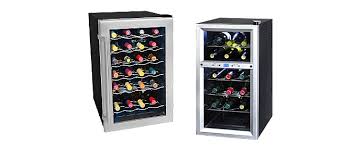best wine cooler in the uk

Wine coolers do just as the name implies: They cool wine. They are not necessary designed to age wine, and they certainly cannot warm wine in cold environments. Wine refrigerators chill your wine to the ideal serving temperature so it is always ready to serve. Most wine chillers can be adjusted to chill wines to 45-65 F. Dual-zone models can maintain two separate zones, such as one at 45 F for whites and one at 65 F for reds. Some can also chill to the low temperature at which many people enjoy sparkling wines (40-43 F). The wine fridges we compared are suitable for indoor use, where temperatures are relatively stable. Generally, compressor-style coolers can cool to lower temperatures, but some prefer thermoelectric coolers since they are quieter and do not contain toxins such as Freon. If you live in a warm area or enjoy sparkling wines chilled to under 43 F, you may want to consider a compressor-style cooler. If you would prefer a thermoelectric cooler, many are adequately satisfied with cooling sparkling wines in a regular refrigerator.

If you are looking for a consistently performing, dual-zone wine cooler, consider the EdgeStar CWF340DZ. If you are looking for a unit with solid-wood shelves, consider the Avanti. Those who are considering a thermoelectric wine cooler may want to consider the NewAir AW-321ED. For a compact, dependable tabletop unit see the Sunpentown WC-20TL. If you would like to learn more about wine fridge temperature fluctuations and are curious about what goes on in our test lab, you can read our articles on wine coolers. Before purchasing a new wine cooler, you will need to consider the type of wine you want to chill, the size of your available space and how many bottles you want to cool. Your geographical location and the temperature of the room where you want the wine fridge may also be important considerations. Additionally, you will want to look at images of the cooler to see if it will fit your aesthetic needs. When comparing wine coolers, we considered the following: We compared operating temperatures and applied accepted industry standard serving temperature ranges to determine the best uses for the specific wine coolers.

Using this information, you can select a wine refrigerator that most suits your needs. We also considered the type of cooling technology used and features designed to help protect your wine, such as light-protected, insulated glass doors. The best wine coolers protect your wine from temperature fluctuations and light. Design details for these free-standing wine coolers include information such as size, shelf type and color. If you have a specific location in your home you need to place your new wine cooler, you will benefit from measuring the space to ensure there is adequate room for the unit and for the required ventilation. Some have attractive wood trim on the shelves and blue LED interior lights that you may find appealing. Many have stainless-steel doors, which compliment most modern appliances. Some offer reversible doors that you either install or have installed when you order the wine fridge. We also noted those that include slide-out shelves and the maximum number of standard-sized bottles each unit can hold.

Locking doors are a helpful option if you need to secure your bottles from small children. Exceptional customer service is an important consideration for a purchase such as a $500 wine fridge. For the most part, we found the warranties to be similar, but you will want to check the details of your warranty and register your unit if required. Additionally, since from time to time appliances require repairs, we searched to see how easy it is to acquire replacement parts.
best wine to drink everydayThe convenience of being able to easily purchase replacements parts online is a nice advantage.
glass of wine lunchAll of these appliance companies provide telephone and email customer support.
best winery near seattle
If you enjoy your wine within a few degrees of optimal serving temperature, a wine cooler can help you achieve this goal. Furthermore, while entertaining you can depend on your wine cooler to make available a variety of wine choices for complementary food pairing or guest preference. For many, a dependable wine cooler is worth the investment. Fans, heating & air treatment
best cheese for red blend wine Digital and smart TV
best red wine gravy for roast beef DVD, Blu-ray and home cinema
wine and food gourmet Compare digital TV packages iPad, Tablets & eReaders Printers, scanners and ink Laptop bags and cases Smart watches and fitness Smart toys and gadgets 1 - 20 of 27 results Brand - A to Z

Brand - Z to A Price – low to high Price – high to low Discount % (Highest to Lowest) 20 products per page Compare items (Up to 4 products) orUse my current location FREE delivery available Dispatched within 10 to 21 days FREE, fast delivery available UV protection & anti-vibration No reviews yet (0) Please complete your details. We'll only use these to contact you about this item. * We'll need this to email you About Best Sellers in Wine Fridges These lists, updated hourly, contain best-selling items.Six weeks after the old one was ripped out, leaving me with nothing but a dirty building site and a large fridge, my new kitchen is in place. It may not have a sink or a hob (yet), but – hooray – finally I can stop living on takeaways and sandwiches because there is an oven (forget the 5:2 diet – I can recommend the No Kitchen diet as a means of losing weight). There is also a wine fridge, which I bought because just occasionally I like to order a case of Interesting Wine from the sort of merchants who only sell by the box of 12, or to tuck away a more special bottle so that on those evenings when you feel you deserve it (or even just really, really want one) there is something decent to uncork.

It ought to be possible to do that without a wine fridge, but in a small London flat it’s tricky. Ideally you need a cellar. Failing that, a well-insulated garage or dark, coolish room is the best bet – avoid bright light sources, heat and external walls (because of their tendency to encourage temperature fluctuation – hot in summer, cold in winter). The best storage temperature is 13C. Failing that, a steady temperature is better than one that fluctuates about the ideal mean. In my old flat, there was no hope – parking a rack 2ft from a radiator and 2ft from the oven was the best I could do. In the spirit of not being defeatist, I stashed all the bottles that had been littering the old kitchen floor, and then stored for six months in goodness knows what conditions with all my furniture, in the gleaming new wine fridge. It’s an under-the-counter Liebherr (ex-showroom model to save money – these things aren’t cheap) that I chose to go in one of the crooks of a U-shaped run of kitchen units where otherwise I’d have had to pay for those expensive internal corner cupboards, thereby offsetting a bit more of the cost.

Many wine fridges are bought to keep wine for only short periods and are more expensive, yet no more effective, than a standard fridge unit. I chose the Liebherr because it wasn’t too dry inside and was fairly quiet. You can adjust the two compartments to different temperatures but I have both set at 13C, the better to replicate cellar conditions. On the first night the new lodger and I were both at home, we decided to celebrate with a bottle of good wine. I decided to start on all those bottles I had in the wine fridge and which I was worried might have been spoilt in some way. It was a depressing exercise. A bottle of 2006 Leflaive was badly oxidised, reminiscent of a white wine I once drank in Cuba, which had been sitting cheerily in bright sunlight and 40C heat. A boutique Côtes du Rhône gave the impression of having been boiled and frozen, boiled and frozen (probably, it had) until it was completely out of sorts. A barolo tasted and smelt almost-good but lacked focus and control, so that drinking it became a painfully nervy, shifty experience, like following a learner driver who keeps speeding up and slowing down and veering towards and away from the central reservation.

And so it went on. Wine after wine not tasting as it ought – not, in fact, tasting like anything on which we wanted to squander alcoholic units. A surprisingly large number seemed to be infested with brettanomyces – a yeast strain that can make wine smell of horses or leather or give it a drying, suede-like texture. Or does poor storage encourage the growth of brett? I don’t know – though there’s no doubt that some of these bottles would have been duff regardless of storage. But I do know that a fresh, bright £5 wine from Aldi would have been a lot more fun than the dozen or so bottles we pulled out, took in turns to taste blind, and chucked away. The good news was that we cleared a lot of dead wine wood, so there is room in the Liebherr for virgin bottles I haven’t already messed up. A case of 2010 chablis can now come out of storage, along with a case of 2004 Langoa-Barton that cost £198 and which I haven’t dared embark on in case I enjoy the first two bottles then find, six months later, the rest are ruined.